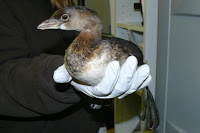Monday, January 18, 2010
Diving Birds Get Help Finding Open Water
Among the wildlife we see more frequently this time of year in our Wildlife Education & Rehabilitation Program are diving birds such as Grebes, Loons, Goldeneyes and Scoters. These birds tend to migrate here from the north during the winter to take advantage of our relatively milder weather. Diving birds have legs that are set far back on their bodies, ideal for propelling them through the water and diving for dinner (as you can see in these photos of our most recent patient.)
While they work "swimmingly" in the water, the placement of these legs are not ideal for walking (some of these birds can’t even walk on land) and they require open water for proper take-off. This time of year, these birds can get stuck on snow-covered land, or in shallow puddles that collect on land and give the appearance of deeper water. Often, all that is required of us is that we get these birds to open water so they can regain their ability to take flight.
In our most recent diving bird case, a Pied-billed Grebe was brought in last week after getting stuck in a water tank. Our rehab staff checked for injuries – these birds can injure themselves as they struggle to get off land. A quick swim in our water tank reassured us that the bird’s crucial waterproofing was intact. Lastly, we confirmed it could gather food.
Wildlife Rehabilitation Specialist Amy LeMonds and Rehab volunteer Christa Sandy were then able to release the bird on Lake Erie last week, in the warm open water near the Avon Lake power plant. By the way, the nearby Miller’s Road boat launch landing is a great place to view these birds during the winter.
You can really see the placement of the legs in the video clips we have posted on our Facebook page and Our YouTube Channel.
Subscribe to:
Post Comments (Atom)


No comments:
Post a Comment